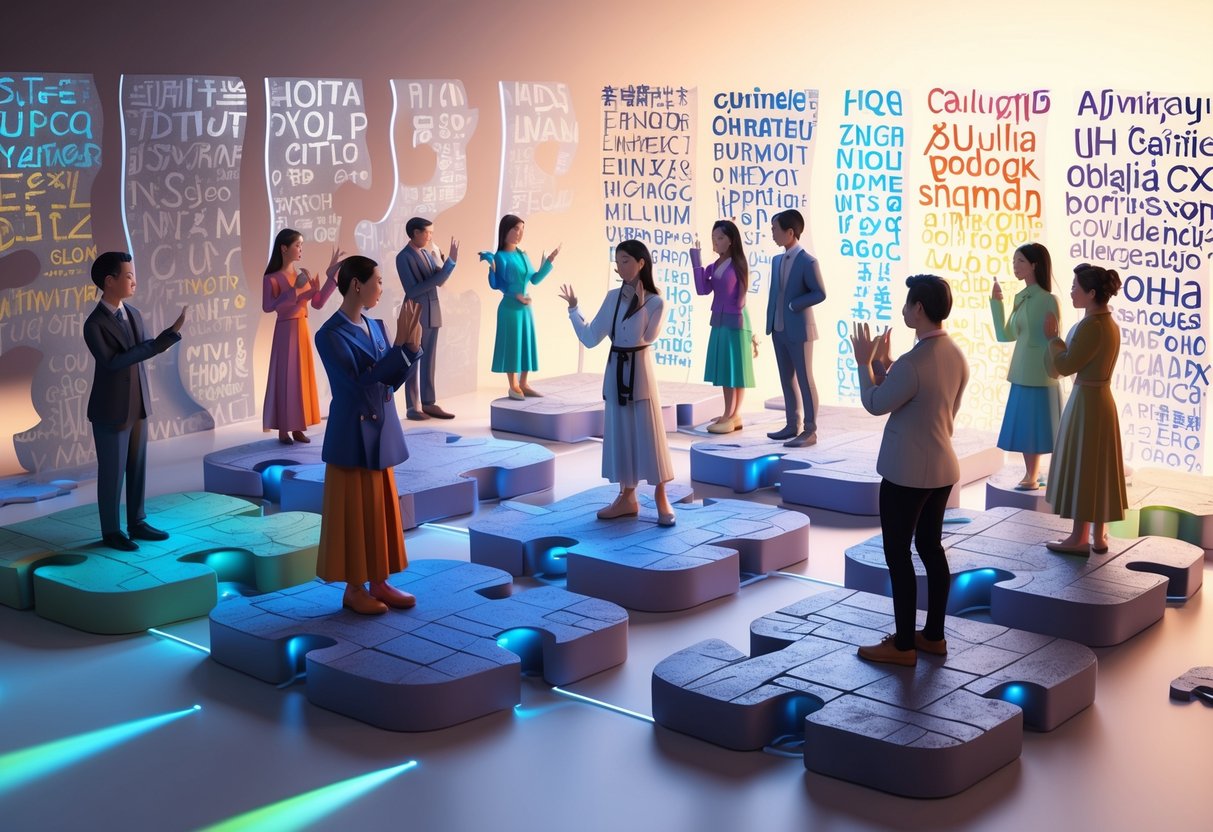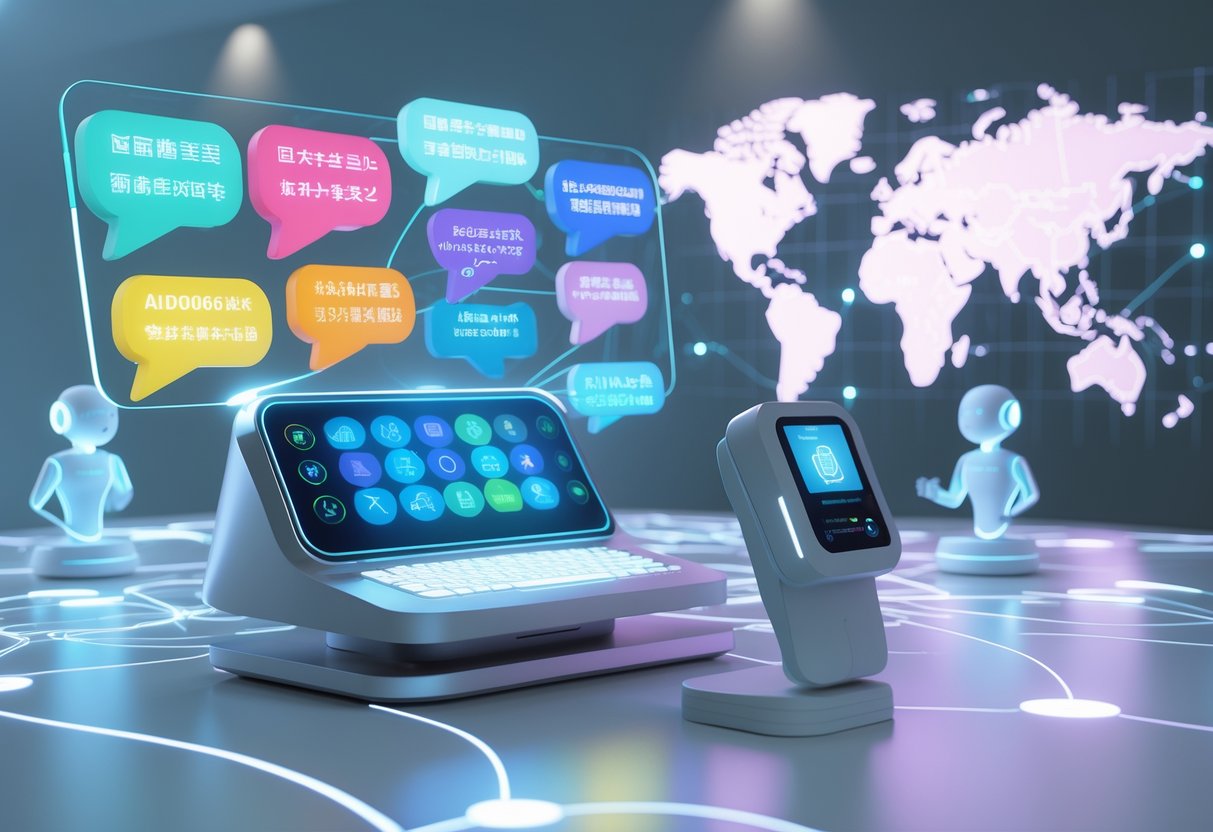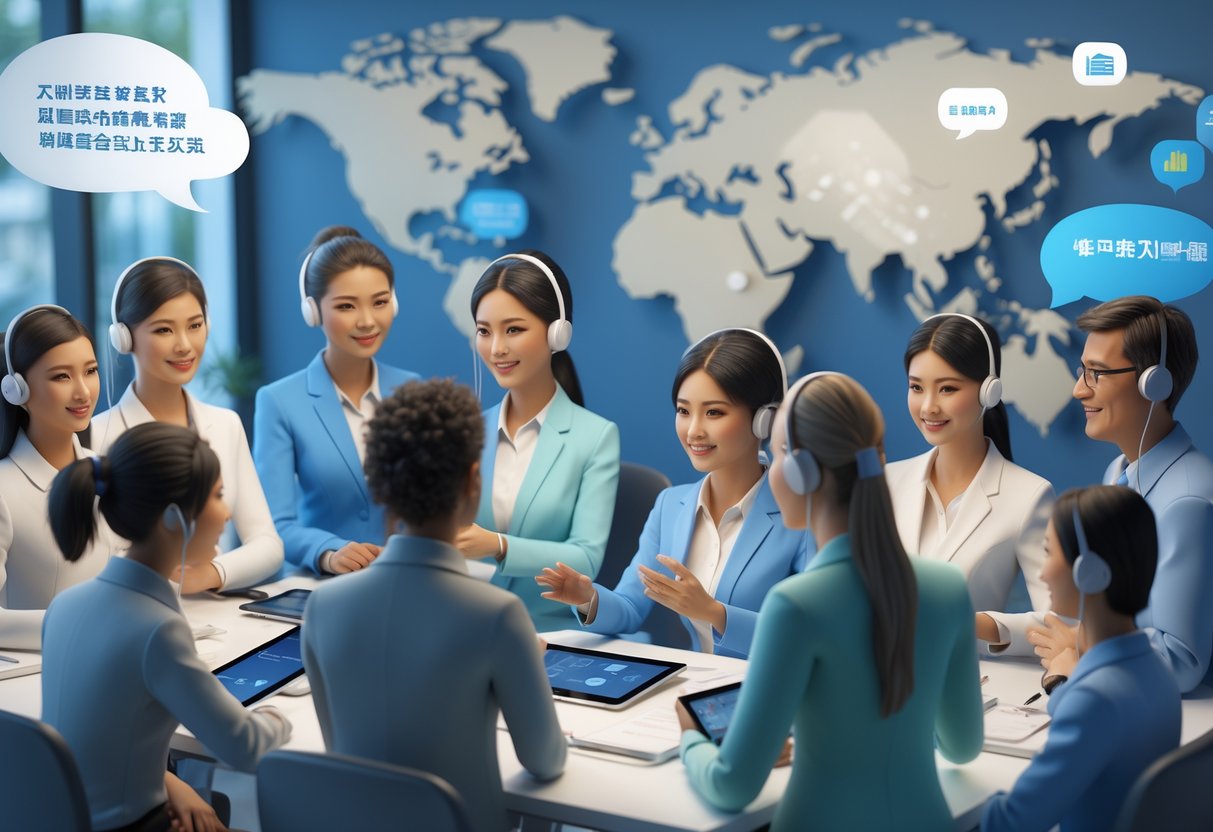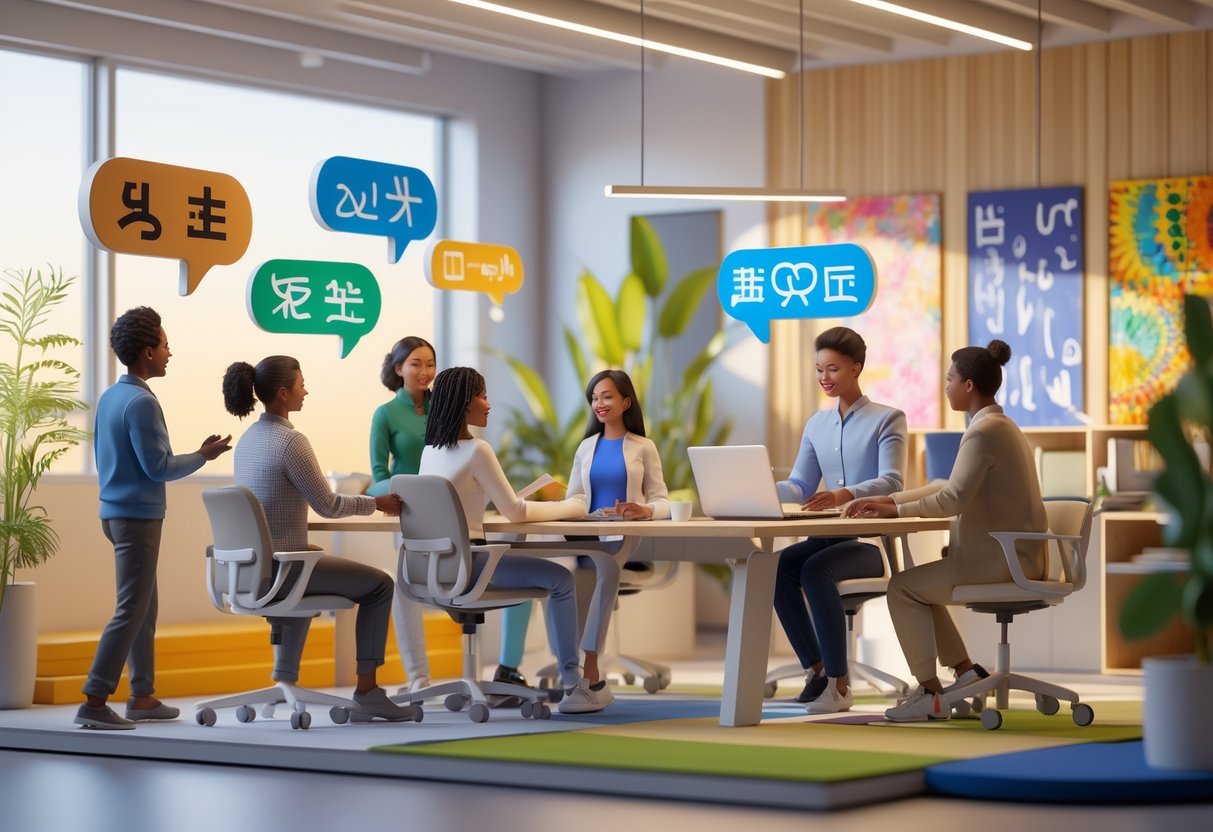Language Barriers: Effective Strategies to Bridge Communication Gaps
Updated On: October 24, 2025 by Aaron Connolly
What Are Language Barriers?
Language barriers pop up when folks can’t connect well because of differences in language, speaking skills, or cultural background.
These communication barriers might be as simple as speaking different languages or as tricky as getting lost in technical terms or cultural references.
Defining Language Barriers
A language barrier blocks clear communication between people.
This happens when they don’t share a language, or their skills in that language just don’t match.
It’s not all about foreign languages, either.
Two English speakers might hit a wall if one uses dense medical jargon and the other sticks to everyday words.
Physical challenges matter, too.
People with hearing loss, speech issues, or learning difficulties can struggle to communicate—even in their own language.
Millions run into these barriers every day.
Misunderstandings pop up in hospitals, schools, offices, and even in online gaming, where players from all over the world try to work together.
Mutual understanding is the real key here.
If the person sending the message and the person receiving it can’t get on the same page, that’s a language barrier.
Common Forms of Language Barriers
Complete language differences are the most obvious kind.
Picture an English speaker in Japan, surrounded by locals who only speak Japanese.
Skill level gaps cause sneakier problems.
A beginner English learner might pick up on simple words but miss the point when grammar or slang gets complicated.
International esports teams run into this a lot since everyone might use English as a second language.
Technical jargon builds walls in every industry.
A doctor explaining surgery to a patient uses words the patient might never have heard.
| Barrier Type | Example | Impact |
|---|---|---|
| Complete difference | Spanish vs Mandarin | No communication possible |
| Skill level gap | Fluent vs beginner English | Partial understanding |
| Technical jargon | Medical vs everyday terms | Confusion over meaning |
| Cultural context | Direct vs indirect communication styles | Misread intentions |
Cultural communication styles can throw people off, too.
Some cultures speak their minds directly, while others dance around the topic.
Even when everyone’s using the same language, these differences cause confusion.
Historical Context of Language Barriers
Language barriers have been around since humans split into separate communities.
On ancient trade routes, merchants needed interpreters just to do business.
The Roman Empire wrestled with language issues all the time.
Latin was the official language, but hundreds of local dialects stuck around, making communication a headache across the empire.
Colonial times made language barriers even more tangled.
European powers forced their languages onto colonized regions, which led to complicated multilingual societies.
A lot of these divisions still linger today.
Globalization changed the scene.
The internet connected everyone, but language gaps stuck around.
Early online gaming was a mess when players couldn’t talk to each other during matches.
Now, technology tries to help.
Translation apps, real-time interpreters, and automatic subtitles make things easier than before.
But honestly, these tools still struggle with context, emotion, and cultural quirks.
English became the go-to business language for many, which helped a bit.
Still, billions of people deal with language barriers in their daily lives and international interactions.
The Causes of Language Barriers
Language barriers pop up for a bunch of reasons.
These range from obvious differences in languages and speaking skills to the habit of using complicated terms that just confuse people.
Linguistic Differences and Dialects
Different languages naturally make communication tough.
Each one has its own grammar, word order, and vocabulary that often don’t match up easily.
Even within a single language, dialects can trip people up.
British and American English have different spellings, pronunciations, and favorite words.
Someone from London might have a hard time with a thick Scottish accent or local slang.
Word order isn’t always the same.
English usually goes subject-verb-object, but Japanese often throws the verb at the end.
Translating directly? Yeah, good luck.
Cultural context is a big deal, too.
Some languages have formal and informal ways of talking, depending on who’s involved.
Miss these cues, and you might accidentally offend someone.
Idioms and expressions almost never translate cleanly.
If you say “it’s raining cats and dogs,” most English speakers get it.
But a literal translation leaves language learners scratching their heads.
Language Proficiency Challenges
Limited fluency in a shared language causes real headaches.
People with basic skills can’t always express complex ideas or follow detailed explanations.
Speaking confidence plays a big part.
A lot of people understand a language better than they speak it.
They might follow what someone says but freeze up when it’s time to respond.
Listening skills vary a ton.
Fast talkers, background noise, or strong accents can make conversations feel impossible for learners.
Reading and writing don’t always develop at the same pace as speaking.
Someone might chat easily in English but struggle with technical documents or formal emails.
Vocabulary gaps pop up all the time.
You might catch the main idea but miss important details because a word or phrase is unfamiliar.
People often hold back out of fear of making mistakes.
That hesitation slows down progress and keeps communication rough.
Use of Jargon and Technical Terminology
Jargon can shut people out—even native speakers.
Medical, legal, and technical terms often leave outsiders lost.
Every profession invents its own language.
Gamers talk about “meta,” “nerf,” or “buff,” which sound like nonsense to anyone else.
Financial folks toss around “liquidity” and “diversification” without stopping to explain.
Academic language can get needlessly complex.
Simple words would do, but sometimes people just want to sound smart.
This makes things harder in schools and formal settings.
Tech manuals and instructions love specialized vocabulary.
Error messages, assembly guides, and software menus assume you know the lingo.
Acronyms and abbreviations make things worse.
Every field invents shortcuts that save time for insiders but leave newcomers scratching their heads.
Doctors might zip through charts full of abbreviations, but patients are left in the dark.
Honestly, simpler words fix a lot.
Swapping “utilize” for “use” or “commenced” for “started” keeps things clear for everyone.
Cultural Influences on Language Barriers

Culture shapes how we talk and listen, way beyond just the words.
Societies have their own ways of sharing ideas and reading signals, and that can lead to all sorts of mix-ups.
Cultural Differences in Communication
Communication styles are all over the map.
Some cultures like to be direct and say exactly what they mean.
Others rely on hints and context.
High-context cultures—think Japan—expect you to pick up on what’s not said.
Low-context cultures, like Germany, want everything spelled out.
Personal space is another big one.
People from Mediterranean countries stand closer when they talk, while folks from Nordic countries keep their distance.
What feels warm to one person might seem pushy to another.
Eye contact isn’t universal.
Western cultures usually see direct eye contact as a sign of confidence.
In some Asian and African cultures, too much eye contact can feel disrespectful, especially with elders or bosses.
Turn-taking in conversations isn’t always the same.
Some cultures jump in and overlap speech to show they’re engaged.
Others wait for a clear pause before chiming in.
These differences can trip people up, even if everyone’s fluent in the same language.
Impact of Non-Verbal Cues and Body Language
Gestures mean different things around the world.
A thumbs-up is a good thing in the UK, but it’s offensive in parts of the Middle East.
Hand movements that seem normal at home might be rude somewhere else.
Facial expressions aren’t always read the same way.
Americans tend to smile a lot, even with strangers.
Russians might save smiles for when they really mean it.
Body posture sends messages, too.
Crossing your legs might be fine in the West, but it’s not always okay in some Asian temples.
Silence isn’t always awkward.
Nordic cultures see silence as a chance to think.
Other cultures get uncomfortable if nobody’s talking.
Physical touch can be a minefield.
Some people greet with hugs or kisses on the cheek, while others keep things formal.
Misreading these signals can sour a relationship before you even get started.
Honestly, these non-verbal mix-ups sometimes cause more trouble than language itself.
Consequences of Language Barriers
Language barriers make life harder in a lot of ways.
Problems range from silly mix-ups to serious isolation, hurting relationships and quality of life.
Miscommunication and Misunderstandings
Miscommunication kicks in when people can’t share or understand info because of language issues.
This leads to confusion and mistakes.
Healthcare is especially tough.
Patients can’t always explain their symptoms.
Doctors might miss what a patient is really saying.
Research shows patients with limited English skills have more medical errors.
Almost half of these patients get hurt by poor communication.
About 35% get confused about their meds.
Common miscommunication problems include:
- Wrong medical diagnoses
- Incorrect medication instructions
- Missed important health information
- Misunderstood treatment plans
At work, language barriers slow everything down.
Team members struggle to share ideas.
Instructions get lost, projects stall, and results suffer.
In schools, students fall behind if they can’t follow lessons.
Teachers have a hard time reaching kids who speak different languages.
Social Isolation and Exclusion
Language barriers can make people feel cut off.
If talking is hard, folks might just skip social events.
Many people give up on making friends when language gets in the way.
Embarrassment about language skills leads to loneliness.
Social isolation shows up as:
- Avoiding social events
- Not joining community activities
- Trouble making new friends
- Feeling left out
About 67% of people facing language barriers have trouble getting basic services.
One in five avoids asking for help because they’re afraid of not being understood.
Families can drift apart when parents and kids don’t speak the same language at home.
That gap creates distance.
At school, students miss out on group activities and social learning if they can’t join in.
Their development takes a hit.
Reduced Trust and Confidence
Language barriers eat away at trust.
When people can’t communicate well, doubts creep in.
In healthcare, 37% of doctors think patients hide important info because of language struggles.
This cycle of mistrust grows.
Patients get frustrated if doctors seem impatient with their language skills.
Trust issues pop up when:
- People feel misunderstood
- Key info gets lost
- Cultural differences get ignored
- Communication keeps failing
Work relationships suffer, too.
Colleagues might judge each other based on language skills, not actual talent.
Service providers lose confidence when they can’t help customers.
Customers get annoyed when they can’t get clear answers.
That damages business relationships.
People start doubting themselves when they run into language barriers.
They might stay quiet in meetings or skip asking questions.
That holds them back at work and in life.
The stress of constant communication struggles wears people down.
It takes a toll on their mental health and well-being.
Language Barriers in the Age of Globalisation
Today, we’re more connected than ever, but language differences still trip us up all the time.
Workplaces and schools bring together people from everywhere, yet remote teams get tangled in miscommunication, and international students hit academic roadblocks just because they don’t speak the same language.
Global Workforce Communication Challenges
The modern workplace stretches across continents, and teams work together from different time zones and cultures. Multinational companies often use English as the common language, but non-native speakers still find it tough to express complicated ideas.
Remote work only makes things trickier. Bad audio on video calls can make accents even harder to understand. Written messages lose tone and context, so people misread intentions and projects suffer.
Key workplace barriers include:
- Technical jargon that doesn’t translate
- Different cultural communication styles (some direct, some not)
- People afraid to speak up because of language worries
- Misread emails causing project delays
Companies try to fix these problems by offering language training or bringing in professional interpreters for big meetings. Translation software helps with basics, but when it comes to contracts or sensitive topics, human interpreters really matter.
Language barriers cost companies a lot. Miscommunication leads to failed projects, missed deadlines, and damaged client relationships—problems that better language support could have prevented.
International Travel and Study Abroad
Language barriers hit hardest when we’re thrown into new environments. International students, for example, face challenges way beyond academic vocabulary—think housing contracts or getting medical care.
Academic settings bring their own headaches. Fast-paced lectures overwhelm students who aren’t native speakers. Group discussions get intimidating when your language skills can’t keep up. Even written assignments suffer because ideas get lost in translation.
Daily life complications include:
- Banking or dealing with admin
- Emergencies where you need help fast
- Social isolation because talking is tough
- Missing out on jokes or pop culture in casual chats
Universities now offer language support services, like writing centres and conversation partners. Still, students often struggle with slang and informal language, which makes making friends and fitting in harder.
Tech helps with translation apps and language platforms. But honestly, nothing replaces the confidence real fluency brings—especially in job interviews or doctor’s visits.
Language Barriers Across Different Contexts

Language barriers pop up in healthcare, education, and the workplace, but each setting brings its own risks. You need different solutions depending on where you are.
Healthcare and Medical Settings
Hospitals face huge risks when language barriers get in the way. Patients who can’t explain symptoms or understand doctors might get the wrong treatment or miss important details.
Critical communication challenges include:
- Doctors might miss symptoms and give wrong diagnoses
- Medication mistakes happen when instructions aren’t clear
- Patients sign consent forms they don’t really understand
Hospitals now hire professional medical interpreters instead of relying on family members. This keeps kids from hearing adult medical info they shouldn’t.
Emergencies make everything harder. Seconds count, and language barriers can slow down care.
Common solutions:
- Phone interpreters available all day, every day
- Video calls with certified medical interpreters
- Picture cards showing pain levels and body parts
| Risk Level | Situation | Solution |
|---|---|---|
| High | Surgery consent | Certified interpreter required |
| Medium | Routine check-up | Phone interpretation service |
| Low | Appointment booking | Multilingual staff or forms |
Some medical terms don’t translate directly. Interpreters have to explain ideas, not just swap words.
Educational Environments
Schools now have more students who speak other languages at home. These kids often struggle to keep up when lessons are only in English.
Language barriers don’t just affect English class. Even maths word problems become impossible if students can’t understand the questions.
Key educational challenges:
- Parents can’t help with homework
- Parents skip meetings because of language fears
- Students feel left out from classmates
Teachers use visual aids and hands-on activities to help. Pointing at things while saying their names helps kids connect words with meaning.
Peer tutoring helps too. Students who share a first language can break down tough concepts for each other.
Support strategies that work:
- Multilingual teaching assistants
- Homework instructions translated for parents
- Buddy systems with bilingual classmates
Some schools send important notices home in several languages. This way, all parents know what’s happening.
Translation apps let teachers give out basic info quickly, but they don’t replace real language support.
Business and Workplace Communication
Global businesses deal with language barriers every day—in meetings, presentations, and daily teamwork. Remote work just makes it more common.
Workplace communication problems:
- Safety instructions don’t get through
- Some team members miss out on casual chats
- Important emails get misunderstood
When people guess at unclear instructions, work gets redone and companies lose time and money.
Companies now offer language training for staff. This pays off with better teamwork and fewer mistakes.
Effective workplace solutions:
- Translate important documents professionally
- Train managers in cultural awareness
- Support multilingual employee groups
| Communication Type | Barrier Impact | Business Cost |
|---|---|---|
| Safety briefings | High accident risk | Legal liability |
| Project updates | Missed deadlines | Budget overruns |
| Team meetings | Reduced participation | Lower innovation |
Video calls with screen sharing help explain tricky ideas. People can point to parts of documents as they talk.
Some companies build glossaries of key terms in several languages. This helps new hires learn industry words faster.
Simple, clear English beats jargon every time. Short sentences and common words keep everyone on the same page.
Technological Tools for Overcoming Language Barriers

Technology keeps breaking down language barriers. With real-time translation apps and smart devices, people can talk across languages instantly—whether in healthcare, business, or just daily life.
Real-Time Translation Solutions
Real-time translation tech instantly turns spoken or written words into another language. These systems use artificial intelligence and machine learning to catch context and deliver better translations than older software.
Voice Translation Features:
- Speak into your device and get the translation right away
- Two-way conversations between people speaking different languages
- Support for 50+ languages in most top apps
- Offline options for places with bad internet
Text Translation Options:
- Point your camera at a sign or paper to read it in your language
- Type a message and let it appear translated for the other person
- Copy and paste text from websites or files
- Handwriting recognition for languages without keyboards
Healthcare gets a real boost from these tools. Medical apps can translate symptoms, treatment steps, and emergency info with medical terms built in.
Accuracy really depends on the language pair. European languages usually get 80-90% accuracy, but less common ones might only reach 45-60%.
Popular Translation Apps and Devices
Google Translate is still the go-to translation tool worldwide. You can use it free on the web or your phone, and it covers over 100 languages—plus it has camera translation and conversation mode.
Key Translation Apps:
- Microsoft Translator: Great for business meetings with many people
- iTranslate: Offers offline packs and voice recognition (if you pay)
- Papago: Focuses on Asian languages and does it well
- SayHi: Simple app for spoken conversations
Dedicated Translation Devices:
- Pocketalk: Handheld device with 82 languages and global data
- Travis Touch: Pocket-sized translator with 155 languages
- Langogo: AI-powered, does real-time translation and doubles as a hotspot
Most apps give you basics for free. If you want offline features or business-level vocabulary, you’ll pay between £3 and £15 a month.
Hospitals now use medical translation apps with pre-translated phrases for common symptoms and procedures. These work better than general-purpose tools for medical stuff.
Practical Strategies to Overcome Language Barriers

Clear speaking and real listening make a huge difference when trying to get past language barriers. These habits help us connect, even if we don’t share a language or are at different skill levels.
Utilising Plain and Clear Language
We can make communication much easier by keeping things simple. Short sentences work best with non-native speakers.
Keep sentences simple. Use active voice. Say, “We finished the project,” not “The project was finished.”
Skip idioms and slang. Phrases like “hit the ground running” just confuse people learning English. Go for direct words with clear meaning.
Explain technical terms if you must use them. If you mention “bandwidth,” add that it means “internet speed” or “data capacity.”
| Instead of | Use |
|---|---|
| “We need to circle back on this” | “We need to discuss this again” |
| “Let’s touch base tomorrow” | “Let’s talk tomorrow” |
| “This is a game-changer” | “This will make a big difference” |
Speak slowly and leave pauses. Give people time to process. Check in by asking, “Does this make sense?” or “Any questions?”
Active Listening Techniques
Active listening lets us really hear and respect others. We focus on the speaker, not just our next reply.
Show you’re listening with nods or eye contact. These little cues encourage people to keep talking.
Ask questions if you’re unsure. Try, “Can you say that another way?” or “What do you mean by…?”
Repeat back what you heard in your own words. This checks understanding and lets the other person clarify if needed.
Notice non-verbal cues—faces and gestures say a lot, especially when language is tricky.
Don’t rush silence. People searching for words in a second language need time. Let them finish their thoughts.
Role of Visual and Non-Verbal Communication

Visuals and gestures can fill the gap when words fail. These tools go hand in hand with speech to help people understand each other, no matter the language.
Using Visual Aids Effectively
Visual aids cut through confusion by giving everyone the same reference. Diagrams, charts, and pictures explain tough ideas without needing words.
Hand gestures work well for quick messages. Pointing, counting on fingers, and simple nods or head shakes are pretty much universal.
Drawings—even stick figures—can lay out steps or processes. They don’t need to be fancy to get the point across.
Facial expressions show how people feel. A smile, frown, or look of confusion is easy to spot, no matter where you’re from.
Quick tip: Use your phone to show pictures or sketch out diagrams if you’re explaining something to someone who speaks another language.
Numbers, symbols, and basic icons help too. Arrows, checkmarks, and X marks are understood almost everywhere.
Visual Communication Methods
Digital tools make visual communication easier than ever. Translation apps can now scan signs or documents with your camera and give you instant translations.
Video calls help because you can see body language and facial expressions. That’s a big step up from audio-only calls.
Screen sharing and shared docs put everyone on the same page—literally. It’s great for walking through presentations or processes.
Heads up: Some hand gestures mean different things in different cultures, so double-check before using them.
Visual schedules and flowcharts make timelines and steps clear. These work especially well in jobs where everyone needs to follow the same process.
Colour coding and highlighting draw
Professional Support and Interpretation Services

Professional interpreters and multilingual staff break down language barriers in healthcare, business, and legal settings. Their help makes communication smoother and ensures everyone gets the information they need.
Working with Interpreters
Professional interpreters step in to provide real-time language support during medical appointments, legal proceedings, and business meetings. They bridge those tricky communication gaps between service providers and people who speak different languages.
In-person interpreters join patients and providers right there in the room. This method feels best for complex medical procedures or sensitive conversations. Hospitals and clinics often choose this for important appointments.
Telephone interpreters connect through phone calls during appointments. This option usually costs less and gives faster access to interpretation services. Healthcare facilities lean on phone interpreters for routine check-ups or quick consultations.
Video interpreters use tablets or computers to offer visual communication support. This method really helps when someone needs sign language interpretation. It also works well when facial expressions matter for understanding.
Professional interpreters boost patient safety and satisfaction. Studies actually show that professional interpreters outperform family members or untrained staff. These experts know medical terms and keep things confidential.
Translation and Multilingual Staff
Translated materials cover forms, brochures, and instruction sheets in several languages. Hospitals and clinics hand out these materials to help patients understand their care. Common documents include consent forms, medication instructions, and appointment information.
Multilingual staff members speak several languages fluently. They can talk directly with patients without waiting for an interpreter. This approach saves time and helps build stronger patient relationships.
Many organisations mix different language support methods. They might use multilingual staff for daily interactions and bring in professional interpreters for more complex situations. This way, they balance cost and quality.
Best practices mean training staff on when to use interpretation services. Asking family members to interpret sensitive medical information? We really shouldn’t do that. Professional services keep things accurate and protect patient privacy.
Building Inclusive and Culturally Competent Environments

If you want to create inclusive environments, you’ll need to develop cultural competence within your teams and set up clear policies that break down language barriers. These steps help organisations support diverse workforces and make sure everyone can communicate across different cultural backgrounds.
Fostering Cultural Competence
Cultural competence starts with realizing that our backgrounds shape how we communicate and work together. We have to recognise that cultural differences affect everything from meeting styles to feedback expectations.
Key areas to develop include:
- Communication patterns – Some cultures like direct feedback, while others prefer more indirect approaches.
- Time orientation – Different perspectives exist around punctuality and deadlines.
- Hierarchy respect – Comfort levels with challenging authority can really vary.
Training programmes should focus on practical scenarios, not just theory. For instance, we might role-play situations where team members from different cultures interpret instructions in their own ways.
Building relationships across cultures takes time and some honest curiosity. When managers learn basic phrases in their team members’ native languages, it shows respect and builds trust. This approach works especially well in diverse environments like professional sports, where coaches who try to speak players’ first languages tend to connect better.
We can also create opportunities for cultural sharing—think lunch-and-learn sessions or cultural celebration events.
Creating Language Access Policies
Language access policies help everyone participate fully, no matter their English proficiency. These policies need to go beyond just basic translation and actually address real workplace communication needs.
Essential policy elements include:
| Policy Area | Requirements | Implementation |
|---|---|---|
| Written materials | Translate key documents | Use professional translators for accuracy |
| Meetings | Provide interpretation when needed | Arrange interpreters in advance |
| Training | Offer materials in multiple languages | Include visual aids and demonstrations |
We should set up clear procedures for requesting language support. That means creating simple forms and making sure staff know how to get help without feeling awkward.
Technology can help with translation apps and multilingual platforms. Still, for complex or sensitive conversations, human interpreters remain essential.
Regular policy reviews let us spot gaps and tweak our approach. Gathering feedback from employees who use these services helps us see what’s working and what needs a rethink.
Frequently Asked Questions

Language barriers cause confusion and missed connections everywhere. These common questions cover workplace challenges, healthcare issues, and practical ways to help people communicate better.
What are some common examples of language barriers in everyday situations?
Language barriers pop up all over the place. Maybe you’ve tried to order food at a restaurant where the staff barely speaks English.
Shopping gets tough when product labels are in a language you don’t know. Public transport can be a headache if announcements aren’t translated.
At school, parents sometimes can’t talk with teachers about their child’s progress. Banking and government services often require forms that just don’t make sense.
Even on social media, posts show up in unfamiliar languages. Neighbours might want to be friendly but can’t chat because there’s no common language.
How can language barriers affect communication in professional settings?
Workplace language barriers slow down projects and sometimes create safety risks. Team members might miss deadlines because they didn’t understand the instructions.
Meetings get less effective if some people can’t follow what’s going on. Email chains become confusing when colleagues struggle with technical terms.
Client relationships take a hit when language differences lead to misunderstandings. Sales can slip away if presentations aren’t clear to international customers.
Training sessions fall flat if employees can’t grasp the content. Safety procedures might get ignored simply because workers don’t understand the warnings.
Remote work makes these challenges even tougher, since people rely more on written communication.
What are some effective strategies for overcoming language barriers?
Simple language beats complicated sentences every time. We should ditch jargon and technical terms when we can.
Visual aids—like pictures and diagrams—make tough concepts easier to understand. Translation apps offer quick help for basic conversations.
Professional interpreters keep important meetings on track. Written materials should be available in several languages.
Cultural sensitivity training helps people get different communication styles. Active listening means really paying attention to what others are saying.
Language classes give people long-term skills for better communication. Honestly, patience helps a lot when working through language differences.
Can you explain the different types of language barriers people might encounter?
Literal barriers happen when people speak totally different languages. Think of a Spanish speaker and a Mandarin speaker trying to communicate.
Proficiency barriers show up when people know the same language but at different skill levels. One person might be fluent, while another only knows basic phrases.
Technical barriers involve specialised vocabulary. A doctor and an engineer might both speak English but use totally different professional terms.
Cultural barriers mix language with social customs. The same words can mean different things in different cultures.
Physical barriers include hearing problems or speech difficulties. These make communication harder, even when people share a language.
Dialect differences create confusion when people speak different versions of the same language.
What challenges do language barriers present in the healthcare industry?
Medical errors go up when patients can’t explain their symptoms clearly. Doctors might miss crucial details about a patient’s condition.
Prescription instructions become risky if patients don’t understand dosages. Emergency situations can turn critical when there’s no time for translation.
Mental health treatment suffers because it’s tough to express emotions in a second language. Patients might skip seeking help altogether if they can’t communicate.
Family members sometimes get left out of big medical decisions. Consent forms mean nothing if people can’t understand what they’re signing.
Follow-up care falls apart when patients don’t get discharge instructions. Trust between doctors and patients breaks down without clear communication.
What solutions exist to address language barrier issues and improve understanding?
Professional translation services get important documents right. They tackle legal papers, medical forms, and business contracts with care.
Interpreter services jump in to help during conversations and meetings. Thanks to video calls, remote interpreting happens just about anywhere now.
Language learning apps and classes help people build real communication skills over time. More employers seem to offer these programs to their teams lately.
Technology brings voice translation devices and smartphone apps into the mix. Honestly, these tools keep improving and surprising me with their accuracy.
Multilingual staff let organizations connect with diverse communities more easily. When native speakers join teams, communication just feels smoother.
Plain language policies push organizations to write simply and clearly. That way, everyone has a fair shot at understanding important details.

